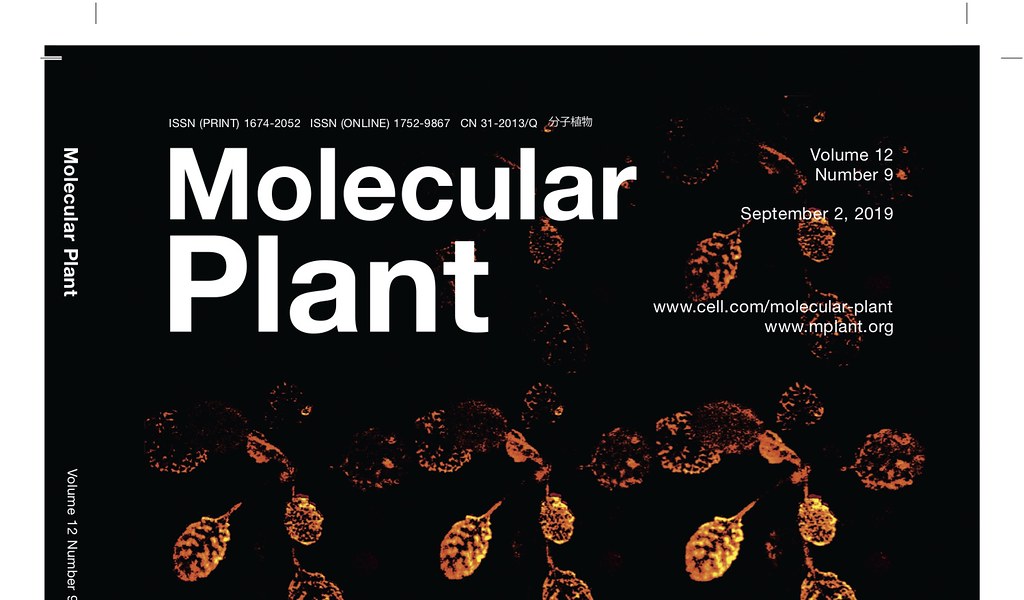
By Mariah Cox | Bond LSC
Plant biologists across the country opened their mailboxes last month to the glowing leaves of Arabidopsis on the cover of the latest issue of Molecular Plant.
That cover taken by post-doctoral researcher Yosef Fichman of Bond Life Sciences Center depicts plants fluorescing in response to reactive oxygen species (ROS) propagation, a technique that allows researchers to track plant response to certain stressors.
The novel approach is the first of its kind to image the response of an entire plant, rather than small samples. To make this technique work, Fichman — who works in the lab of Bond LSC’s Ron Mittler — and his collaborators came up with the idea to fumigate the plant with a dye which enters the plant, reacts with ROS inside the plant and fluoresces under an in vivo imaging system (IVIS). From there, the researchers could watch the stress signals of the plant as they evolve in real-time following the application of different stresses.

ROS are essential regulators of cellular and systemic signals in plants as well as animals. Additionally, they play an important role in hormonal, physiological, and developmental reactions in plants such as growth and development as well as defense and acclimation to environmental stress.
ROS are both beneficial and detrimental to plants. On one hand, they regulate basic biological processes. On the other, if overproduced, they are toxic to cells and can cause cell stress or death. However, recent research by the Mittler lab supports the idea that, at certain levels, ROS can be more beneficial than harmful because they have the power to signal defense mechanisms against stressors in the environment. In essence, it is a way for cells to communicate with each other, creating a domino effect, or wave that sends a message to nearby cells and eventually over long distances within the plant.
Now that they have a technique to detect the fast-moving ROS signal in plants, the researchers can identify the proteins that are involved in the plants’ response to stress. The signal is important because it causes fast adjustments to stress within the environment, which means that other parts of the plant that are not subject to stress can build up protection mechanisms.
“In order to understand plants’ response to stress, we need to know the mechanism of that’s going on in plants,” Fichman said. “Basically, it’s a balance of resources within the plant.”
Currently, the researchers are working with Arabidopsis, but this technique applies to other plant and crop models. Previous methods of tracking biological responses in plants included the arduous process of gene manipulation and expression. The new method allows for a straight-forward approach to tracking and monitoring the biological reactions in plants.
Moving forward the researchers plan to use Arabidopsis mutants and other plants to track the response to different stresses compared to the wild type to see if there are changes in the genes involved. Fichman is particularly interested in the effect of abiotic stresses, such as high-intensity light and leaf destruction by insects.

“Whether you like to call it weather extremes or global climate change, there are changes. Plants are a main food source, so we need to be prepared to create better plants for the future that allows crops to grow in stressful conditions such as high light, less water and heat,” Fichman said. “If plants invest more resources into protecting themselves they will be able to survive these changes and continue to produce food for our future. I’m studying this mechanism in ROS waves and in different pathways to create better plants in the future.”
By understanding the proteins that are involved in plants’ response to stress, researchers can begin to re-engineer plants to survive harsher conditions. Fichman’s technique makes it easier to recognize plants’ responses to stress moving forward.
For Yosef, when it comes to research, imagination is the only limitation.
“In research, we can come up with the craziest ideas and science allows us to check those ideas and discover new things,” Fichman said. “This is why I wake up in the morning.”
This research was published in the September 2019 edition of Molecular Plant.

